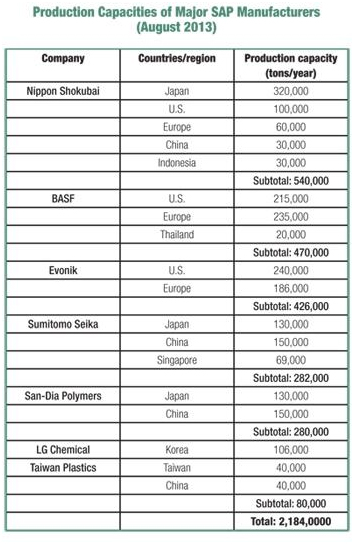
The global super absorbent polymer market is expected to grow at a CAGR of 5.5% from 2014 to 2019 to reach a value of US$8.56 bln, as per Markets and Markets. The SAP used for baby diapers segment is growing at a CAGR of 5.2% and constitutes a significant part of the overall super absorbent polymer market. The market is expected to be pushed by bio-based SAP and increasing income levels, and rapidly growing baby diaper market in the emerging regions. Due to increasing population and income levels in Middle East, Africa and Asia-Pacific, especially in India and China, the emerging geographies are expected to register maximum growth.
SAP crystals, sometimes called super absorbent polymer balls, water absorbing crystals or slush powder, have numerous practical applications. These typically are cross-linked acrylic homo-polymers (usually sodium neutralized). Diapers and hygiene product manufacturers use super absorbent polymers as the solidification medium in the products. In agriculture they are used to increase the water absorption and water retention in soils located in regions subject to drought. Hospitals utilize them to solidify and dispose-off bio-hazardous waste in suction canisters. Oil companies utilize them to solidify the liquid waste byproducts of oil and gas drilling, and mining. Acrylic Acid is the main consumed raw material for the super absorbent polymer products. The demand for super absorbent polymer is increasing and will continue to increase as the disposable income of the individuals are increasing and population pyramids in the Asia-Pacific and Middle East, Africa.
The fastest growth in the super absorbent polymers market is expected to come from SAP used in construction, packaging, wire and cable, oil and gas, fire fighting which will continue to expand in the coming years. Expansions and new investments for SAP plants in the recent past have indicated that the industry is on its way to expand globally and global SAP suppliers are strengthening their presence in emerging markets. All these factors, along with the growing diaper industry, will continue to drive the demand for SAP. However, the SAP industry will have to overcome challenges, such as the availability and price volatility of raw materials and changing health regulations, in order to meet the increasing demand from the growing diaper industry. North America, Europe, and Asia-Pacific dominated the super absorbent polymer market in 2013 and accounted for over 75% of the market. The developed regions dominate the SAP market due their mature markets which consist of hygiene conscious and high-spending population. Country wise, U.S. is the top most consumer of super absorbent polymer product globally and is also its largest market for growing at a CAGR much lower than the global average till 2019. Japan is the largest SAP consumer for adult diapers in the world and also the second largest super absorbent polymers market within Asia-Pacific. On the other hand, Middle East, Africa is expected to witness the fastest-double digit growth rate by 2019. The market in this region is experiencing increase in baby diaper penetration rate, high disposable incomes and population pyramids. While baby diapers take topmost positions in the super absorbent polymer market with more than 75.2% share by value. The fastest growth rate till 2019 in the super absorbent polymers market is expected to come from SAP used in construction, packaging, wire and cable, oil and gas, fire fighting which will continue to expand in the coming years. Sodium polyacrylate dominates the SAP market by type in terms of volume and value. |
 |
Previous Article
Next Article
{{comment.DateTimeStampDisplay}}
{{comment.Comments}}